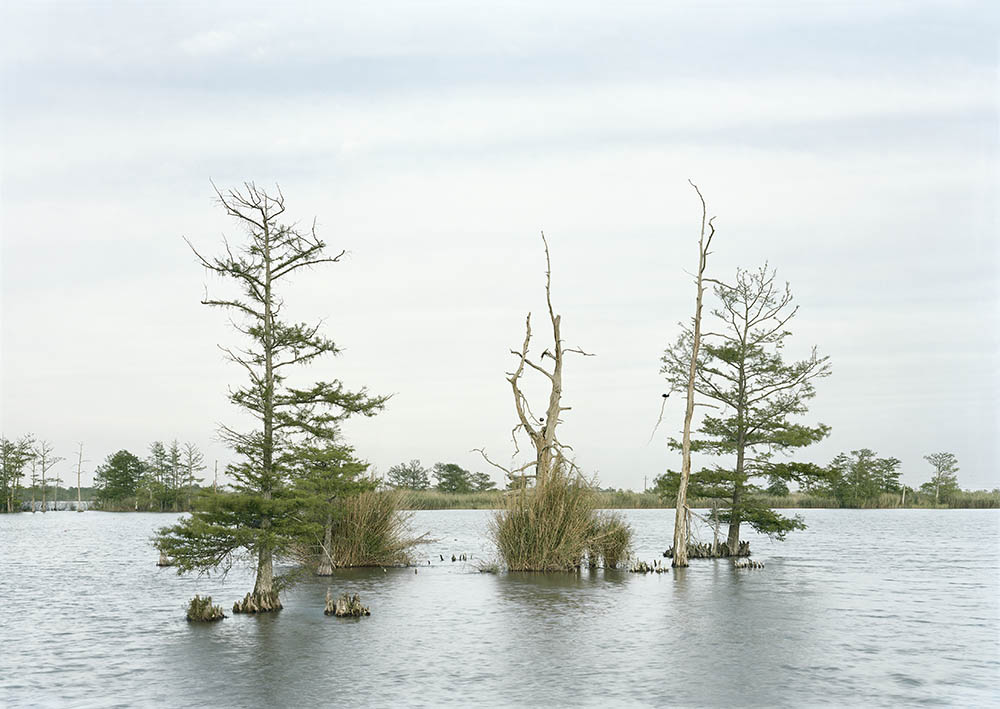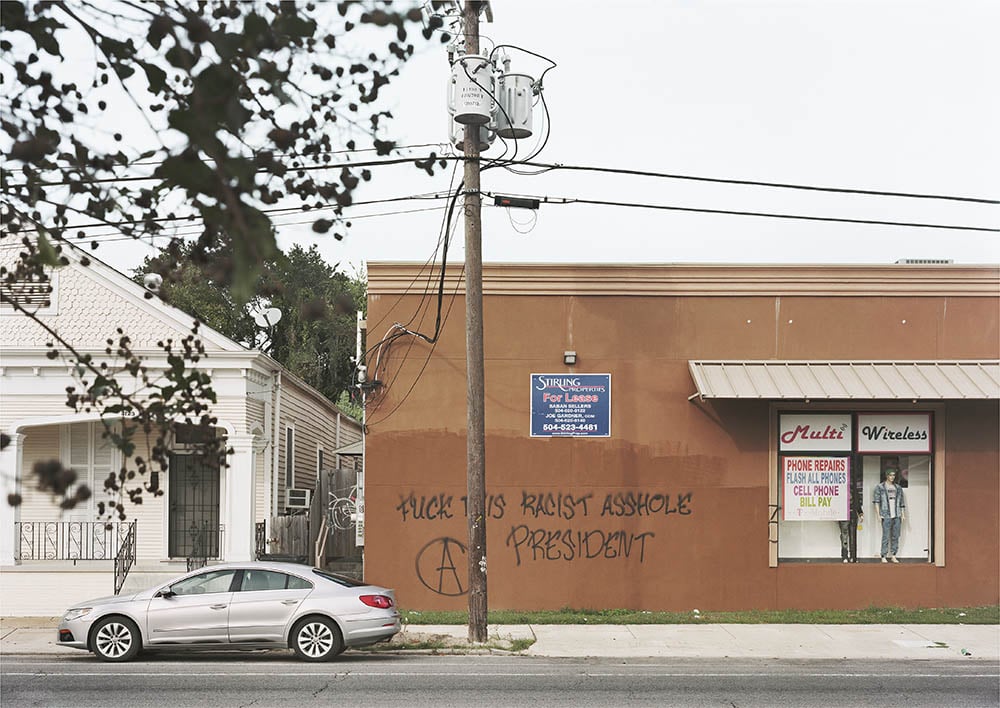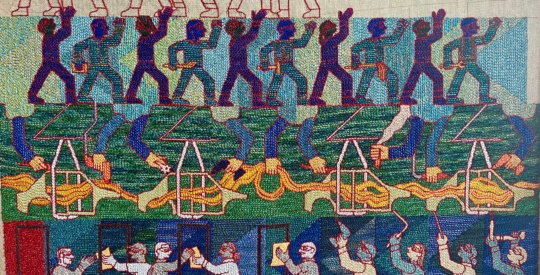
The photographer An-My Lê came to Bvlbancha—the Choctaw name for what is now called New Orleans—in November 2016 to document the chaotic atmosphere surrounding the removal of four confederate monuments slated to be taken down after years of activism by city residents and the community-led group Take ‘Em Down NOLA.[1] She and I were connected during her visit because An-My wanted to learn more about the Vietnamese American community in Southeast Louisiana. I moved to Bvlbancha in 2015 to conduct research for my dissertation through learning from Vietnamese American fisherfolk about the environmental harm and structural exclusion they respond to in the Mississippi Delta. I did this work primarily through Coastal Communities Consulting (CCC), a nonprofit working to secure the everyday needs of fisherfolk by providing translation services in Vietnamese, Khmer, and Spanish; training in accounting and other skills; immigration and naturalization support; and more. My role there was to advocate for workers in the commercial fishing industry in rooms where decisions were being made about the land and water they rely on for their livelihoods.
Two days after our first meeting in a French Quarter coffee shop, An-My, her assistant Max, and I traveled down eighteen-wheeler-worn Louisiana Highway 23 on our way to two shrimping docks in the Mississippi River’s bird-foot delta. As we headed south, our rattling truck driven by Sandy Nguyen, CCC’s executive director, Max and An-My commented on the narrowing land and rising levee, indicators of how close we were getting to the Gulf.
Later in the day, further along the narrow peninsula, we saw shrimp boats docking and unloading their catches, and heard from Sandy and the fisherfolk about what it’s like to depend on an environmental sacrifice zone.[2] The minute we pulled up to the first dock in Buras, Sandy pointed to a watery expanse and exclaimed, “We used to play soccer over there! The guys we work with, they’ve seen all of this land disappear.” This wasn’t the first time I had heard the soccer story—Sandy, like everyone who loves and depends on the delta, reminds anyone who will listen just how much she and her family have already lost, and what they still have to lose if things don’t change.
Because of its porousness, marshland subsides or sinks over time naturally, but the large-scale loss we observed that day was accelerated by French settlers, who stripped the coast of the cypress forests whose root systems had held it together and protected it against the destructive effects of storm surges. Logging exacerbated this ecosystem’s collapse, abetted by the colonial insistence on white men’s primacy over the Mississippi River, the Gulf, and the surrounding land, all of which were taken from the Houma, Biloxi-Chitimacha, Choctaw, Chickasaw, and other Indigenous communities.[3]
Today this destruction is compounded by oil and gas exploration (which allows salt water to quickly erode land through pipelines and exploratory channels) and commercial shipping (which has resulted in the widening and deepening of the Mississippi River). It is clear that the people living in the Mississippi Delta are not considered when capital can be extracted from the landscape.[4] This ecological sacrifice, underwritten by environmental racism, is as embedded in the land of coastal Louisiana as the oil itself.

Sandy and I discussed these layered histories of harm with An-My and Max on our way to a dock in the unincorporated community of Venice-Triumph. Run by a man called Handy,[5] a Vietnamese refugee of the US War in Việt Nam, the dock is almost entirely staffed by workers from Central America. During our interactions with him, Handy consistently referred to the workers as his family. Like them, having experienced the violence of living through and trying to escape a war backed by the United States, Handy has done everything in his power to make sure that one immigrant family in particular—a man, his brother, and his son—are protected from many of the forces that could destabilize their lives. Having introduced us, the dock owner often draped his arm across the man’s shoulder, proudly declaring, “This is my son!” despite the man being only a few years younger than Handy. The complicated, often ad hoc families that folks make on the coast and across the Gulf South are direct responses to the imperative of environmental sacrifice: if these men choose each other as kin—treat each other as kin—then they will help keep each other’s families, homes, labor, and futures alive.
Survival is particularly important in places like Venice-Triumph, where—as Handy explained to An-My while she set up her camera—the storm always hits first and hardest: “I have rebuilt this dock at least three times—twice in 2005, when Rita came a month after Katrina, and once in 2008 after Gustav and Ike.” Pointing up to the tin ceiling overhanging the dock, looking both sad and resolute, he continued: “It blew off—always. I told my wife we should leave and start a corner store up the road, but she shook her head and said, ‘No, this is what we do.’ We build it back better every time.” In two sentences, Handy illustrated how impossible it is for him to make a stable life between the river and the ocean. Either he lives here on the coast doing what he loves and rebuilds over and over following ever-escalating natural disasters, or he struggles to find employment—being past middle-age, having only fishing-specific skills, and speaking imperfect English—in another place.
Reasserting his commitment to Venice-Triumph and his family, Handy explained: “I don’t know how much longer we will be here. The shrimp are smaller every year—after BP [the oil spill catastrophe in 2010], they never came fully back.” The workers in this industry—made up of Indigenous, Black, Southeast Asian, Central American, and Cajun and other white families—have joined the parade of communities whose labor sustains Louisiana but whose lives its state officials and policy makers are willing to sacrifice in favor of corporate profits.


After a full day of documenting the delta, An-My, Max, and I headed back to Bvlbancha, leaving Sandy behind to “shoot the shit” with “her fishermen.” As we crossed the Huey P. Long Bridge and whipped around the Central Business District on I-10, An-My pointed out the window to the ten-story-high statue of Robert E. Lee. “I need to get him before they take him down.” Max took the next exit.
We roamed around the massive roundabout that Robert E. Lee towered over, trying to find a vantage point from which An-My could get a good shot of the monument. One man let us into his apartment, but the cigarette soot on his windows obscured the statue from view. The low-ceilinged dive bars we peeked our heads into were too short, and the fancy hotels the general peered into were not interested in our cause. The photograph that An-My ended up making from the street is context-dense in a way than an aerial view would not have been. Her image of a white supremacist effigy—naturalized in an historically Indigenous area and a Black city’s landscape—at a time when its removal was imminent is particularly extraordinary.
In the weeks that followed, white supremacists arrived in Bvlbancha with machine guns, confederate flags, and Trump banners to “defend” Lee and the three other statues slated for removal. They occupied monument sites that lionized slavery and settler occupation with a sense of conviction, many of them pitching tents and settling in for the long haul. At the monument of confederate general P.G.T. Beauregard, his descendants convened to fortify his legacy. They claimed that the man who initiated the Civil War at Fort Sumter was reformed enough upon his death for a statue of him—depicted mid-battle— to remain on public display.
As the statues came down one by one—first the Battle of Liberty Place monument, then Jefferson Davis, P.G.T. Beauregard a few days later, and, finally, Robert E. Lee—the white supremacists left the city. To capitalize on the amount of press this process had received, then-mayor Mitch Landrieu wrote a book about his success in supervising the removal of these statues. In his book, Landrieu neither highlights his years-long resistance to Take ‘Em Down NOLA’s organizing nor does he acknowledge the fact that dozens of white supremacist monuments remain, dotting the city’s landscape like festering wounds.


In the wake of George Floyd’s murder by Minneapolis police in May 2020, the public discussion about white supremacist monuments has been reinvigorated. In August, as Hurricane Laura bore down on Southwest Louisiana, residents of Bvlbancha and its bird-foot delta marked the fifteenth anniversary of Hurricane Katrina. On August 29, I attended the Gulf Coast Center for Law and Policy’s virtual commemoration of this anniversary, which they had shifted programmatically to instead support communities recently devastated by Laura. After several healers and community leaders shared art, altars, and calls to action, Malik Rahim—one of the organizers of Louisiana’s Black Panther Party and co-founder of Common Ground Relief—began his keynote by asking, “What lessons have we learned [since Katrina]? Are we truly prepared for the next disaster?”
Safe in my apartment in Dionde:gâ’—the Seneca name for Pittsburgh—I listened to Rahim answer this rhetorical question, thinking about the commercial fisherfolk I continue to work with. As Tropical Storm Marco had headed up the coast earlier that month, the fleet who docks at Handy’s had stayed on their boats, ready to steer their livelihoods away from wreckage. Shortly after, however, when Hurricane Laura subsumed Southwest Louisiana, many of the same folks brought their boats across the state for search-and-rescue missions and to provide sorely needed showers and food to first responders and residents. This was not because of some sort of innate resilience but because the conditions of white supremacy and environmental sacrifice require those who live under them to create networks of care that circumvent state harm.
“As goes the Gulf, so goes America. As goes America, so goes life as we know it,” Rahim later said in his speech. He was right: as the Gulf’s culture washes away, so does that of the United States. But perhaps in a place where white supremacy is equally visible in the form of confederate monuments in city squares and uncertain working conditions at water’s edge, the resistance we witnessed—whether rebuilding chosen families or tearing down memorials to racist violence—can fundamentally change what we understand American life to be. Vivid and frank, An-My’s images show both possibilities: the impossible present and, hopefully—as in the image of two statues of confederate generals quarantined in storage—what is to come.
[1] Take ‘Em Down NOLA is a Black- and community-led group whose driving principle is “We don’t need a renaming commission; we need an entire restructuring of the system.”
[2] The term “sacrifice zone” has never been officially defined by a single scholar in the US, but refers to a space or place that, by proxy of being inhabited by primarily people of color or economically disadvantaged folks, is slated for environmental sacrifice—traditionally, pollution or other toxic harm—by decision-makers based on who lives there.
[3] For more about this, read Craig Colten’s book Southern Waters: The Limits to Abundance, (LSU Press: 2014).
[4] Macarena Gómez-Barris defines an extractive zone as “the logics of colonial seeking that depict land and territory as [spaces to extract from], as if it is there for the taking, to be owned” and which “violently reorganizes territories as well as continually perpetuates dramatic social and economic inequalities” (Duke University Press:2017).
[5] Name has been changed.
This essay was featured in the Waterways / Water Wars section of Laws of Salvage: The 2020 Burnaway Reader.




